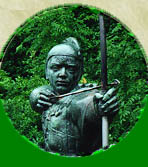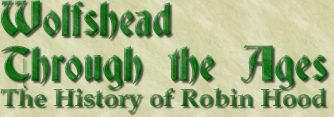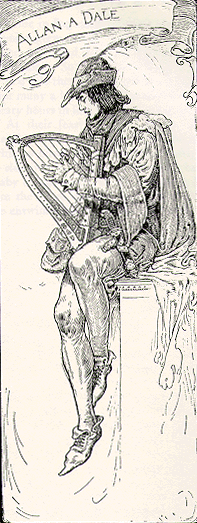
|
CHANGES TO THE ROBIN HOOD LEGEND
Some street ballads embellished old medieval tales. For example, the idea of Robin making a final shot and asking to be buried where the arrow landed as added to a medieval story about The Death of Robin Hood . Many told tales of harmless combat, which Holt thinks may have been inspired by the May Games. Several ballads follow a simple formula. Robin meets stranger (usually a tradesman); Robin picks a fight; Robin gets the crap kicked out of him; Robin blows his horn for help and asks the stranger to join his band. Sure, there's a medieval ballad where Robin Hood and Little John are defeated by a potter . But when the Merry Men get their butts kicked by the butcher, the tanner , the pindar , the tinker , and every other sort of common worker, you have to wonder why it is that the sheriff is having such a tough time with the outlaw. Robin had his skull cracked so many times, you'd think he wouldn't have the wits to outwit a village idiot, let alone the sheriff. But then, that's the great joy of these tales. Robin Hood is a man of the people and commoners can beat him easily. Elements from the plays, like his new well-to-do background as an earl or his love Maid Marian rarely appear in these tales. Something else happened in this period. New ballads were being written -- origin stories. In the medieval ballads, Little John and the rest were always outlaws. We never found out how they joined the band. Now, the stories could be told. (Although it is always possible that some of these stories did exist in some form during the Middle Ages, and the earlier versions have been lost to us. The ballads Robin Hood and The Golden Arrow and The King's Disguise and Friendship with Robin Hood retell sections of the Gest, a medieval ballad that was lucky enough to survive to the present day.) Robin meets Little John or Will Scarlet (who had become a Gamwell, and Robin's cousin) or a disguised Marian . Robin picks a fight. John or Will or Marian kicks the crap out of Robin. Robin invites them to join the band. One member of the Merry Men who doesn't fight Robin Hood, Alan a Dale , is a character new to the legend. The minstrel showed up asking Robin to rescue his lover (there's a reference to an early version where Will Scarlet is the distraught lover, not Alan). The story was popular enough that Alan a Dale's managed to stick around as a part-time member of the Merry Men. Another new character was Will Stutely , who Robin rescues in a ballad. Stutely shows up in many Robin Hood books, but he never quite achieves the pop culture stardom of Alan a Dale or the more important band members. But still, he pops up more often these days than Clorinda, the shepherdess lover of Robin in tales like Robin Hood's Birth, Breeding, Valour, and Marriage . While Clorinda didn't become a regular part of the Robin Hood canon (only appearing in a few stage productions), many of these broadside ballads did. The ballad collections were later adapted into prose "Lives" and later children's novels. The broadside ballads may stood the test of time, but they were shorter and less sophisticated than some of the early ballads. 19th century ballad collector Francis Child deplores the drop in quality. For example, of Robin Hood and the Monk, Child wrote "Too much could not be said in praise of this ballad, but nothing need be said. It is very perfection in its kind." ( The English and Scottish Popular Ballads, vol. III (of the 5-volume edition, p.95) Now contrast that with his description of the 17th century ballad Robin Hood and the Tinker. "The fewest words will best befit this contemptible imitation of imitations." (p.127). If you're interested in seeing what the broadside ballads actually looked like, visit the Broadside Ballads Online website from the University of Oxford's Bodleian Libraries which has a fully searchable collection of the ballads in their original form. Not only were new ballads being written and widely distributed, but an older ballad was published for the first time. In 1765, Bishop Thomas Percy added Robin Hood and Guy of Gisborne to the literary canon with the publication of his Reliques of Ancient English Poetry. The ballad was included in the 17th century folio manuscript that Percy had acquired, but as mentioned in previous sections, with its violent tone and plot similarities to the 1475 dramatic fragment, the Gisborne ballad is often given an honorary place in the medieval tradition. (With his brief mention of "those tyrannical forest-laws, that were introduced by our Norman kings" in his introduction to the ballad, Percy also planted the seed of a tradition that was to bloom in the 19th century, as you'll read in the next section.) Many ballads also found their way to North America. For example, a version of Robin Hood and Little John survives in Virginia. And several ballads survived in Canada's east coast. For example, Bertrand Harris Bronson laments the survival of the lesser ballad Robin Hood and the Prince of Aragon (or Oregon in the Canadian version) in "forty-six rather deplorable stanzas". Still this ballad is shorter than the English version, and several lines are slightly different. This ballad was recorded in 1928 by George Herzog, "learned from his father sixty years before". In Canada, the ballads survived through such an oral tradition. Ballad collector Helen Creighton found some Robin Hood ballads from Nova Scotia. These include Robin Hood and Little John (more like the British version than the American one), two versions of Bold Pedlar and Robin Hood (or Pedlar Bold). There are also two tunes for Robin Hood's Progress to Nottingham, but even by combining stanzas from both versions, Creighton only found four surviving verses. What the Nova Scotian folk musicians remembered was Robin brutally slaying the foresters and then hacking off the arms and limbs of Nottingham townspeople. Obviously the blood-and-thunder moments held the most appeal.
North America's contribution to the legend grew far beyond this oral folk tradition (as you'll see in the sections covering children's novels, film and television). Robin also continued to appear on the stage, but the theatrical productions witll be described in a later section. In addition to the ballads and garlands, there were several prose versions of "The Life of Robin Hood" The one appearing in the Sloane Manuscript circa 1600 mentioned previously is an early example. A later example is a book from 1737 titled (in part) The whole life, and merry exploits of bold Robin Hood, Earl of Huntington and it compiles The Whole Life and Strange Adventures of Robin Hood and history of another outlaw, Johnny Armstrong. This Life summarizes elements from many ballads including Robin Hood's Birth, Breeding, Valour, and Marriage, the Bishop of Hereford (although it's the bishops of Carlisle and Ely who appear), the Jolly Pindar of Wakefield, Allen a Dale, the Butcher, Tanner, the Curtal Friar, Tinker, Robin Hood's Progress to Nottingham (although not in its traditional place as the first adventure) Robin Hood's Golden Prize, The Noble Fisherman, Robin Hood and Queen Katherine, Robin Hood's Chase and A True Tale of Robin Hood. The 1737 Life also provides details of Robin Hood's childhood, telling us "His Father and Mother were so fond of him, that they let him suck till he was two Years old". It goes on to speak of Robin Hood's education saying he "became the head Scholar, and so by that he was call’d the Captain of the School". One almost longs for the Robin Hood of the medieval ballads -- the one who appeared to have no past, no relatives and no dubious school days. Robin inherits the estate of his uncle Squire Gamwell (who appears in Robin Hood's Birth, Breeding, Valour, and Marriage and in other stories is the father of Will Scarlet). This does not turn out well.
As the Whole Life goes on, Robin has furious battles where his outlaws slaughter hundreds of the king's men and the bishop's men. And in a plot development familiar to modern audiences, the outlaw hero steals the king's taxes. (As mentioned previously, this was not a part of the medieval legend.) The 1737 Whole Life ends with Robin Hood's epitath - one which appeared in different variations in various ballads, garlands and other accounts of the time.
The 1737 Whole Life says Robin was lived in "Loxy" - an error for the more traditional Loxley or Locksley. It was one of many textual errors. At the end of the century, a scholar would come along to clean up such mistakes, compile the old ballads and summarize the legend in a way that would re-shape the legend for centuries to come. You can read about him in the next section. Next: Revolutions and Romanticism Sources and Further Reading: Thanks to Alan Lupack at The Robin Hood Project at the University of Rochester for allowing direct links to the ballads. Click here to view additional information sources used for this specific section. Wolfshead Through the Ages is only a small part of a much-larger site filled with information about the Robin Hood legend. To read more of the ballads, check out the Robin Hood Tales section. Text copyright, © Allen W. Wright, 1997 - 2013. |

 These ballads were cheap and could be purchased by just about anyone.
They weren't great works of literature. In fact, unlike the surviving medieval
ballads, they were meant to be sung rather than read. In the opening stanzas
of many broadside ballads we find words indicating the tune, such as "With
a hey down down a down down" or "Hey down derry derry down."
These ballads were cheap and could be purchased by just about anyone.
They weren't great works of literature. In fact, unlike the surviving medieval
ballads, they were meant to be sung rather than read. In the opening stanzas
of many broadside ballads we find words indicating the tune, such as "With
a hey down down a down down" or "Hey down derry derry down."